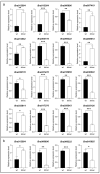Expression Characterization of ABCDE Class MADS-Box Genes in Brassica rapa with Different Pistil Types
- PMID: 37299197
- PMCID: PMC10255268
- DOI: 10.3390/plants12112218
Expression Characterization of ABCDE Class MADS-Box Genes in Brassica rapa with Different Pistil Types
Abstract
MADS-box is a vital transcription factor family that functions in plant growth and development. Apart from APETALA2, all genes in the ABCDE model that explain the molecular mechanism of floral organ development belong to the MADS-box family. Carpel and ovule numbers in plants are essential agronomic traits that determine seed yield, and multilocular siliques have great potential for the development of high-yield varieties of Brassica. In this study, ABCDE genes in the MADS-box family from Brassica rapa were identified and characterized. Their tissue-specific expression patterns in floral organs and their differential expression in different pistil types of B. rapa were revealed by qRT-PCR. A total of 26 ABCDE genes were found to belong to the MADS-box family. Our proposed ABCDE model of B. rapa is consistent with that of Arabidopsis thaliana, indicating that ABCDE genes are functionally conserved. These results of qRT-PCR showed that the expression levels of class C and D genes were significantly different between the wild-type (wt) and tetracarpel (tetrac) mutant of B. rapa. Interestingly, the expression of the homologs of class E genes was imbalanced. Therefore, it is speculated that class C, D, and E genes are involved in developing the carpel and ovule of B. rapa. Our findings reveal the potential for the selection of candidate genes to improve yield traits in Brassica crops.
Keywords: ABCDE model; Brassica rapa; Chinese cabbage; MASD-box genes; flower development; multilocular silique; tissue specificity.
Conflict of interest statement
The authors declare no conflict of interest.
Figures






Similar articles
-
Genome-wide analysis of the MADS-box gene family in Brassica rapa (Chinese cabbage).Mol Genet Genomics. 2015 Feb;290(1):239-55. doi: 10.1007/s00438-014-0912-7. Epub 2014 Sep 13. Mol Genet Genomics. 2015. PMID: 25216934
-
Systematic analysis of MADS-box gene family in the U's triangle species and targeted mutagenesis of BnaAG homologs to explore its role in floral organ identity in Brassica napus.Front Plant Sci. 2023 Jan 12;13:1115513. doi: 10.3389/fpls.2022.1115513. eCollection 2022. Front Plant Sci. 2023. PMID: 36714735 Free PMC article.
-
Genome-wide analysis of the MADS-box gene family of sea buckthorn (Hippophae rhamnoides ssp. sinensis) and their potential role in floral organ development.Front Plant Sci. 2024 Jun 13;15:1387613. doi: 10.3389/fpls.2024.1387613. eCollection 2024. Front Plant Sci. 2024. PMID: 38938643 Free PMC article.
-
Homeotic Genes and the ABCDE Model for Floral Organ Formation in Wheat.Plants (Basel). 2013 Jun 25;2(3):379-95. doi: 10.3390/plants2030379. Plants (Basel). 2013. PMID: 27137382 Free PMC article. Review.
-
The orchid MADS-box genes controlling floral morphogenesis.ScientificWorldJournal. 2006 Jul 14;6:1933-44. doi: 10.1100/tsw.2006.321. ScientificWorldJournal. 2006. PMID: 17205198 Free PMC article. Review.
Cited by
-
Genome-Wide Identification of the NAC Gene Family in Brassica rapa (L.) and Expression Pattern Analysis of BrNAC2s.Plants (Basel). 2025 Mar 7;14(6):834. doi: 10.3390/plants14060834. Plants (Basel). 2025. PMID: 40265765 Free PMC article.
-
Analysis of the Causes of Split Pit in Peaches.Int J Mol Sci. 2025 Jun 6;26(12):5460. doi: 10.3390/ijms26125460. Int J Mol Sci. 2025. PMID: 40564924 Free PMC article. Review.
-
Identification of VvAGL Genes Reveals Their Network's Involvement in the Modulation of Seed Abortion via Responding Multi-Hormone Signals in Grapevines.Int J Mol Sci. 2024 Sep 12;25(18):9849. doi: 10.3390/ijms25189849. Int J Mol Sci. 2024. PMID: 39337335 Free PMC article.
-
A mutation in CsGME encoding GDP-mannose 3,5-epimerase results in little and wrinkled leaf in cucumber.Theor Appl Genet. 2024 Apr 28;137(5):114. doi: 10.1007/s00122-024-04600-5. Theor Appl Genet. 2024. PMID: 38678513
References
-
- Angenent G.C., Colombo L. Molecular control of ovule development. Trends Plant Sci. 1996;1:228–232. doi: 10.1016/S1360-1385(96)86900-0. - DOI
Grants and funding
LinkOut - more resources
Full Text Sources

